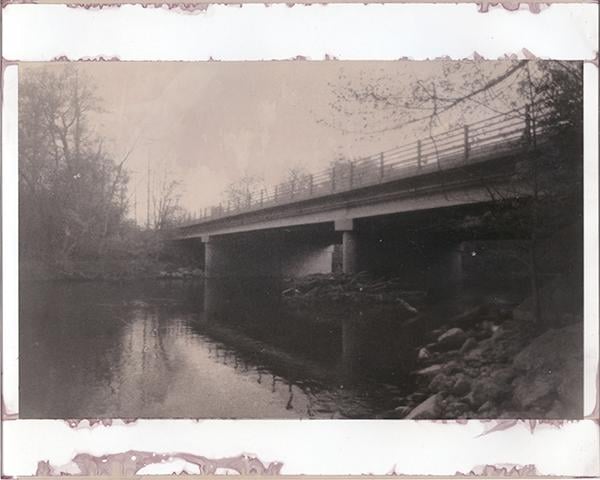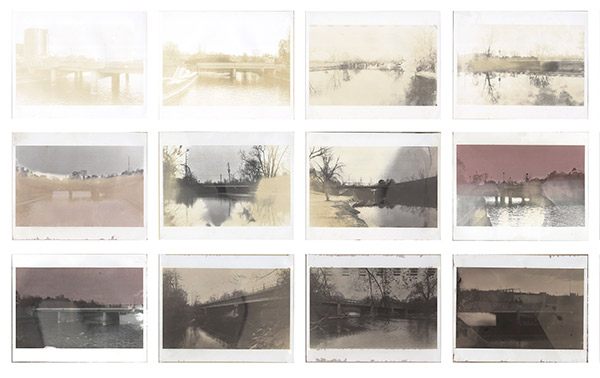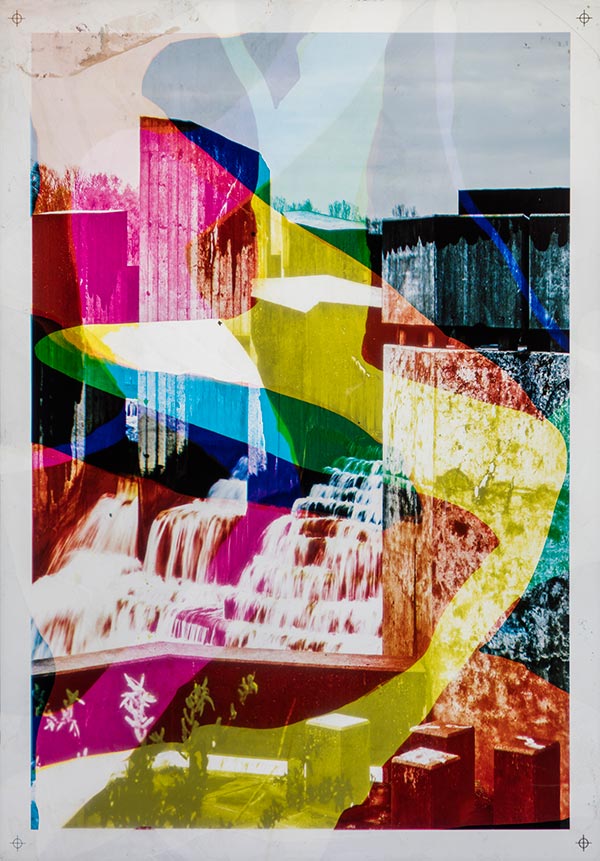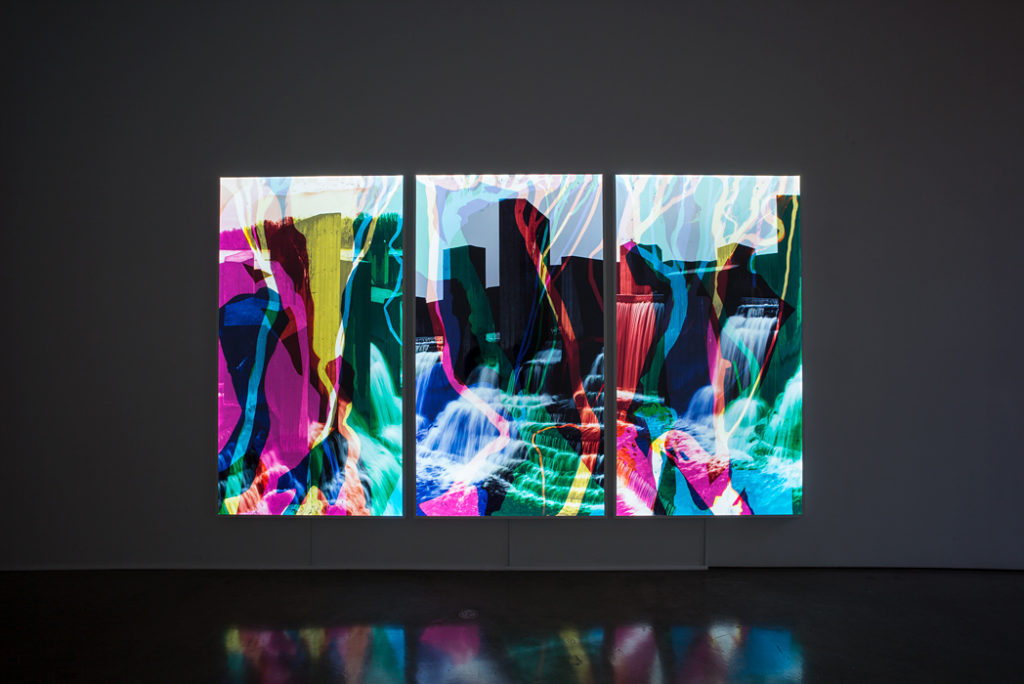On View
The Detroit Institute of Arts Has Bought Murky Photographs That an Artist Developed in Water From Flint, Michigan
Photographer Matthew Brandt took a toxic turn for his series "Bridges Over Flint."

Photographer Matthew Brandt took a toxic turn for his series "Bridges Over Flint."

Sarah Cascone

The distorted, faded colors of Matthew Brandt’s “Bridges Over Flint” photography series aren’t just an aesthetic choice. Brandt developed the negatives using a solution of Flint, Michigan, tap water and vitamin C, turning the resulting gelatin silver prints into physical evidence of the dangers Flint residents faced when, in 2014, the city switched from supplying treated water to Flint River water and contaminants caused lead from the town’s pipes to leach into the water supply.
Brandt photographed locations around Flint with black-and-white 35mm film. In order to accentuate the water’s impurities, “I toned the prints with red wine and applied bleach over some areas,” he told Shutterbug. Together with the lead and other toxins inherent in Flint’s water, this caused unexpected effects in the printed image. The work is a reminder of the dangers, invisible to the naked eye, faced by the people of Flint during the water crisis.

Matthew Brandt, installation shot of the “Bridges Over Flint” series (2016). Photo courtesy of Yossi Milo Gallery, New York; ©Matthew Brandt.
Now, the Detroit Institute of Arts has acquired all 24 prints in Brandt’s “Bridges Over Flint” as part of its ongoing efforts to collect works of art that address regional concerns. The photographs are currently on view, along with other recent acquisitions, in “Out of the Crate: New Gifts & Purchases.”
“Visually, the toning and bleaching of the prints obscures and suppresses a clear and fully legible image of the riverscape,” said Nancy Barr, DIA’s photography curator, in an email to artnet News, praising the work as Brandt’s most political project to date. “Overall, the manipulated imagery presents a visual analogy suggestive of the murky and toxic water itself, as well the lack of clarity surrounding a full resolution and closure to the continued crisis.”
In a second series, Brandt photographed Flint’s dam at Stepping Stone Falls and color-separated the large-scale images into red, cyan, and magenta layers printed on three individual Duraclear sheets. He left each sheet immersed in the river water, as pumped into a bath in his studio, for weeks before reuniting the newly eroded layers in LED light boxes.

Matthew Brandt, Stepping Stone Falls 9 C2M1Y2 (2016), from the “Waterfalls (Stepping Stone Falls)” series. Photo courtesy of Yossi Milo Gallery, New York; ©Matthew Brandt.
For Brandt, the Flint water project is a natural extension of his practice. The artist consistently processes his photography with substances produced by his subjects, like tar from the La Brea Tar Pits, or breast milk. For a series of photos of peaches, Brandt devised a method similar to that used to make albumen prints, substituting a peach pie-like filling for egg whites to create a light-sensitive paper. As a result, each photo is a kind of science experiment, utterly dependent on the chemistry.
Brandt first began this approach while taking portraits, for which he’d collect his subject’s sweat and saliva and use the sodium content to develop the image. The use of bodily fluids “seemed to be a pretty good way of representing that person versus me just taking a photograph and printing it,” Brandt told Burnaway. “Literally putting them in the picture-making process seemed to be a step towards or attempt at a kind of realism, and I’ve been doing that ever since.”
“I had been considering Matthew’s work for our collection at the DIA for some time because of his interest in the American landscape as a subject for his art, and his conceptual approach to photographic subject matter and the medium’s materiality,” said Barr. “[‘Bridges Over Flint’] seemed not only timely as the events in Flint continue to be on the minds of many individuals here and globally, but relevant to the DIA’s permanent collection not only now but for the future.”

Matthew Brandt, River and Sky (2016), from the “Waterfalls (Stepping Stone Falls)” series. Photo courtesy of Yossi Milo Gallery, New York; ©Matthew Brandt.
Meanwhile, the Flint Water Crisis is still not fully resolved. Because the river water was not treated with corrosion inhibitors, contaminants caused lead from the town’s pipes to leach into the water supply. These unsafe drinking conditions caused dangerous blood-lead levels in children, which can cause permanent developmental damage, and possibly led to an outbreak of Legionnaires’ Disease that killed 10. Even though water quality returned to acceptable levels in 2017, residents are still advised to drink filtered or bottled water until Flint’s lead pipes have all been replaced, in 2020.
In an effort to fight the city’s beleaguered reputation, Flint residents voted on Tuesday in favor of a new tax to support museums and the arts in the area, including the Flint Institute of Arts and the Sloan Longway museum.
“Matthew’s work continues to perpetuate awareness regarding the issue,” said Barr. “Although there have been efforts to clean up the Flint River and repair the water systems, many Flint citizens, particularly children, continue to be affected by the crisis.”
“Out of the Crate: New Gifts & Purchases” is on view at the Detroit Institute of Arts, 5200 Woodward Avenue, Detroit, July 14–September 23.